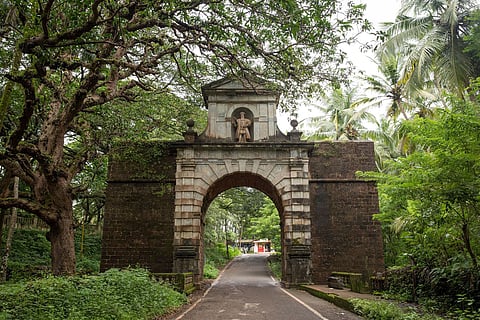A symbol of the bygone Portuguese era, this stately gateway is a portal to Goa's colonial past!
To commemorate the accomplishments of Vasco Da Gama, his grandson, Francisco Da Gama, built the Arch of Viceroy, after he took over Goa as a governor. Located on the Divar Ferry road, towards the Mandovi River, the arch served as the main entrance to Old Goa, initially.
Said to be established in 1597, a place of crucial ceremonial importance during the Portuguese rule, this arch is now a major attractions for tourists in Goa. The Viceroy's Arch is also said to be one of the gates of the Adil Shah's Palace and if you have an eye for history, then read on to know more about this structure.
A special place in the state's tourism itinerary
[rebelmouse-proxy-image https://media.rbl.ms/image?u=%2Ftravelshoebum.com%2Fwp-content%2Fuploads%2F2018%2F04%2Fimg_1124.jpg%3Fresize%3D1000%2C1333%26ssl%3D1&ho=https%3A%2F%2Fi1.wp.com&s=181&h=1eee4fc072acc2468b4d2a1845c8d7872a85621da6e8a089f79cfd600de3cde5&size=980x&c=948465246 photo_credit="" pin_description="" dam="0" site_id=20074994 caption="" photo_credit_src="https://i1.wp.com/travelshoebum.com/wp-content/uploads/2018/04/img_1124.jpg?resize=1000%2C1333&ssl=1" crop_info="%7B%22image%22%3A%20%22https%3A//media.rbl.ms/image%3Fu%3D%252Ftravelshoebum.com%252Fwp-content%252Fuploads%252F2018%252F04%252Fimg_1124.jpg%253Fresize%253D1000%252C1333%2526ssl%253D1%26ho%3Dhttps%253A%252F%252Fi1.wp.com%26s%3D181%26h%3D1eee4fc072acc2468b4d2a1845c8d7872a85621da6e8a089f79cfd600de3cde5%26size%3D980x%26c%3D948465246%22%7D" expand=1]
Among various exquisite architectural monuments in Goa, the Viceroy's Arch holds a special place in the state's tourism itinerary, owing to its rich historic background. It has been said that during the Portuguese rule, each governor received the ceremonial key after they walked through the arch, as a ritual after taking charge. The dome, however, lost its stately importance as the capital of the state was changed from Old Goa to Panjim in 1843.
Meet Vasco Da Gama personally!
[rebelmouse-proxy-image https://media.rbl.ms/image?u=%2Fvi%2F9iugWIzF6ZA%2Fmaxresdefault.jpg&ho=https%3A%2F%2Fi.ytimg.com&s=123&h=2a7e5febb5ba7ed700cfa4184af4528ff00952995e68bbdbe1820d6c257c75c9&size=980x&c=3791957503 photo_credit="" pin_description="" dam="0" site_id=20074994 caption="" photo_credit_src="https://i.ytimg.com/vi/9iugWIzF6ZA/maxresdefault.jpg" crop_info="%7B%22image%22%3A%20%22https%3A//media.rbl.ms/image%3Fu%3D%252Fvi%252F9iugWIzF6ZA%252Fmaxresdefault.jpg%26ho%3Dhttps%253A%252F%252Fi.ytimg.com%26s%3D123%26h%3D2a7e5febb5ba7ed700cfa4184af4528ff00952995e68bbdbe1820d6c257c75c9%26size%3D980x%26c%3D3791957503%22%7D" expand=1]
Right at the entrance of this historic monument stands a statue of Vasco Da Gama in a royal attire, gazing at the Mandovi river. He was the first European to reach India by sailing through the 'Cape of Good Hope'. Before the collapse in 1948, the arch originally had a sculpture of St. Catherine on the other side. However, the restoration process in 1954 did not include the statue and consequently, the bronze figurine was shifted to the Goa Museum.
The mystery of the Crowned Woman!
[rebelmouse-proxy-image https://media.rbl.ms/image?u=%2F2375%2F2347193049_fb2cf4f958_b.jpg&ho=https%3A%2F%2Flive.staticflickr.com&s=908&h=a209b41bc23ee079fb2b8e620bb1bbb9699db5bbb4162df7263d2d6ef6a6cca1&size=980x&c=1573625929 photo_credit="" pin_description="" dam="0" site_id=20074994 caption="" photo_credit_src="https://live.staticflickr.com/2375/2347193049_fb2cf4f958_b.jpg" crop_info="%7B%22image%22%3A%20%22https%3A//media.rbl.ms/image%3Fu%3D%252F2375%252F2347193049_fb2cf4f958_b.jpg%26ho%3Dhttps%253A%252F%252Flive.staticflickr.com%26s%3D908%26h%3Da209b41bc23ee079fb2b8e620bb1bbb9699db5bbb4162df7263d2d6ef6a6cca1%26size%3D980x%26c%3D1573625929%22%7D" expand=1]
The posterior part of the arch has another statue of a lady with a crown, holding a sword in one hand and a book in the other. Under her feet, lies the statue of a man in a decorated robe and turban. This statue is considered to have a symbolic value. Legends have it, that this statue symbolises the victory of christians over other Pagan religions.
Apart from this, the reasons for building the arch have been engraved on the insides of the archway. Portugal's independence from Spain in 1640, also has a separate slab to its account. The slab hails Dom Joao IV as the true king and the restorer of Portuguese liberty.
To avail the best experience here, we recommend you to hire a guide and unravel the history of this monument. The Viceroy's Arch is open for the public every day from 7:30 in the morning to 6 in the evening. Make sure you check out and follow the COVID guidelines before planning your trip to this gateway to Old Goa!
To get all the latest content, download our mobile application. Available for both iOS & Android devices.

